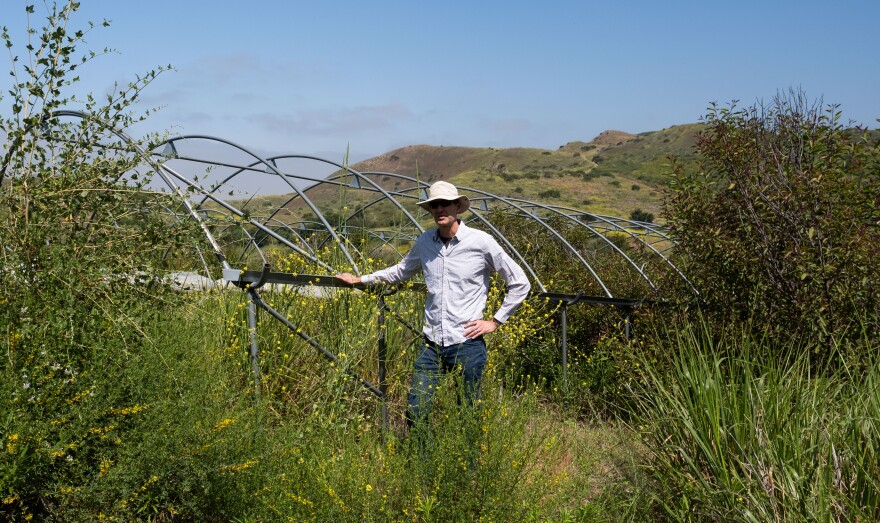With our free press under threat and federal funding for public media gone, your support matters more than ever. Help keep the LAist newsroom strong, become a monthly member or increase your support today.
What happens when you keep a plot of land in permanent drought?

In the Santa Ana foothills high above Irvine, you'll find some small patches of land beneath hoop houses that've been deliberately kept in drought for the past 17 years.
While the hills around them are verdant and covered in native shrubs, the vegetation beneath the structures looks scraggly, and invasive plants like black mustard are taking over.
Every time a major storm comes along, researchers from UC Irvine head out into the field to extend plastic sheeting over the dirt to keep water from reaching it.
The goal is to reduce rainfall by almost half, and to keep these patches of earth in drought for such a long time, we gain insight into what climate change has in store for our landscapes — especially as droughts intensify.

The changes we can see
I visited the site in late spring with Steven Allison, a microbial ecologist at UC Irvine who’s leading the Loma Ridge Global Change Experiment.
For about two decades, they’ve been taking regular soil moisture samples, cataloging vegetation and capturing microbes so they can compare the state of the plots to what’s happening across the surrounding landscapes.
“Drought, we know now, affects every part of this ecosystem," said Allison. "From the plants to the surface soil, and even down deeper in the soil."
There’s been a decline in the number of native plants in the plots, as they’ve struggled to survive and stay established due to the dry conditions. With the soil open to colonization, invasives have moved in, making it more difficult for the natives to return.
It’s something we’re already seeing on hills across Southern California, with plants like ripgut brome and storksbill outcompeting coastal sage scrub, one of the most at-risk types of vegetation we have that's compromised by drought, fire and development. We often see type conversion, or when the ecosystem that was once there completely shifts to another — like from shrubland to grassland, or from a grassland to bare dirt.
And as ecosystems shift, not only do their appearances and functions change, but so do how they interact with the world around them.

An example was seen in 2020, when the Silverado Fire burned through the area.
The drought plots had a lower density of native plants present, so when the fire came through, they burned at a lower intensity than the surrounding land. That might sound like a good thing, but the fire didn't get hot enough to kill off invasive plant seeds, setting the stage for domination by plants like mustard.
Compare that to the surrounding area, which has had more native plant reestablishment than the drought plots.
Meanwhile, in the plots, the invasives will grow quickly and theoretically be able to carry fire at shorter intervals than if they were filled with natives, jeopardizing the native plant seed bank and potentially ecosystem recovery.

The changes we can't
Allison and his colleagues have documented changes to the soil microbiome as well.
Plants and microbes often have a mutually beneficial relationship, with the plants releasing sugars through their roots, feeding the microbes, and the microbes breaking down nutrients and making them available for the plant to take up. When the plants die, it's microbes that help break them down and return nutrients to the soil.
When those plants disappear or extreme conditions like drought arrive, the complementary microbes can decline, making a comeback more difficult.
To make things worse, black mustard can thrive without that same mutualistic microbe relationship, and it releases an allelopathic chemical that can impede native plant growth.

“You can see that the plant growth is smaller and weaker under the drought treatment. And if we look below ground, we can see that the microbes are also changing and their abundance may be declining. Their function may be declining,” said Allison.
They’ve yet to nail down what changes in microbes can be applied at a larger landscape scale, as well as what each microbe is responsible for across different ecosystems.
What is clear is that the right microbes make a difference in the health of plants.
Allison hopes that someday they'll be able to identify a handful of key microbes that'll help native plants thrive during restoration efforts.
"We could just spray on the native microbes that maybe we could cultivate in a lab or a bioreactor and that then would promote the restoration success. It's a little bit pie in the sky, but you know, that may be necessary if we have really large areas of habitat that need restoration and are lacking their native microbes," he said.

What's the tipping point?
It's the big question that kept coming up in our conversation: At what point are ecosystems so degraded that they're unlikely to recover?
There were some plots that had to be let out of drought after seven years, due to a lack of funding. The good news is that they were able to recover before funding came along to stick them back into drought again.
“Our concern is that we’ve passed that tipping point in our experimentation,” said Allison.
Like any study, there are limitations. The climate we’ve experienced over the past 17 years isn’t going to be exactly like the one we’ll experience in the next 50, as extreme heat days increase in frequency as well. It’s not completely clear how coastal sage scrub ecosystems as a whole will respond.
The experiment is expected to continue for the foreseeable future.








